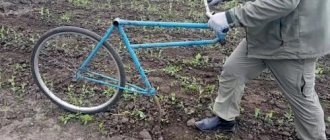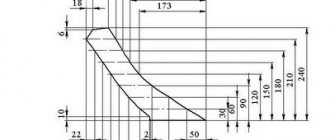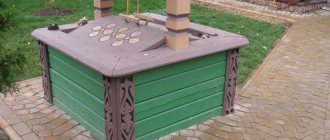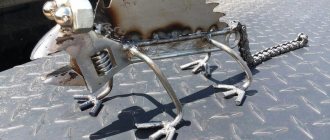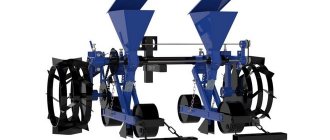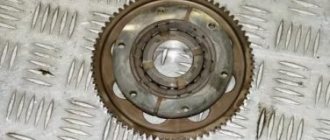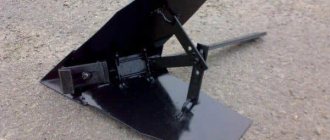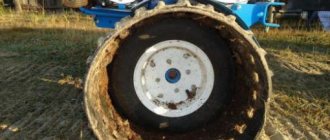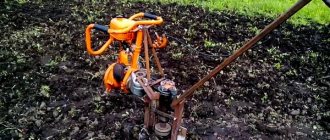Lugs for walk-behind tractors should be in the arsenal of any owner of such a device. They are quite common among farmers, as they allow you to increase weight and traction with the ground. You can make lugs for a walk-behind tractor without any problems with your own hands, even without much experience. They have a simple shape, and you can now see many different modifications of the device on the market.
Why do you need do-it-yourself lugs for a walk-behind tractor?
Of course, to a large extent the quality of work depends on the weight of the unit. You can hang all the most functional awnings only on heavy walk-behind tractors and medium-heavy devices. But the heaviness and professionalism of the walk-behind tractor is not everything. If you have a seemingly cool unit, but don’t get the desired results, you should purchase wheels with lugs for the walk-behind tractor. You can buy, or you can make lugs for a walk-behind tractor with your own hands. It all depends on the size of the wallet, desire and directness of hands.
Standard lugs for walk-behind tractors are metal wheels with spikes that bite into the ground and connect the walk-behind tractor with the soil. In order to make lugs for a walk-behind tractor with your own hands, you will need knowledge of the design of lugs (the drawing and diagram will seriously make this task easier for you), determine the diameter of the canopy, select the material for converting into lugs for a walk-behind tractor, and, of course, tools for working with the original material. Essentially, it's a grinder and a welding machine.
Before making lugs, decide on their size. The height and width of the lugs depends on the task for which you place them on the walk-behind tractor. Later we will discuss what sizes the factory lugs that you can buy in the store can be.
And also the requirements for the severity of the lugs. After all, you put on wheels with lugs in order to improve the traction of the walk-behind tractor with the ground, and for this you need a good weight of the wheels, which the walk-behind tractor itself may not have enough. The minimum weight of wheels is 20 kg. You can also add weights to the lugs if you want to get a better result or the weight of the wheels is not up to standard.
Combined holds
Such devices are needed not only for walk-behind tractors. Many are also interested in the question of how to make lugs for a cultivator with their own hands. For these purposes, you can use combined wheels, for example, using a tread from a tractor.
To implement such a project, halves of Zhiguli wheels should be prepared. It is also necessary to prepare tractor tires with strong tread. Then you need to cut the sides. This results in a rubber circle with excellent tread.
Such wheels can be used on hard dirt roads, as they will not loosen the ground. They will also perform well on soft ground, but the grip on the ground will be much less than with metal discs.
If you need a wheel option not only for good traction with the ground, but also for loosening, then you need to make knife lugs that will not drive on regular roads, but are only suitable for loosening. This way the land will be cultivated.
How to make lugs for a walk-behind tractor with your own hands
The simplest answer to the question of how to make lugs for a walk-behind tractor with your own hands is to take unnecessary rims from car wheels for future lugs. We need to attach an axle shaft to these disks using a welding machine, onto which we will then put bearings. Weld metal square plates to car rims. So that the edges of the plates touch the rim.
The plates then need to be screwed to the rim with bolts. Now we need to make teeth - steel hooks that will go into the ground. To do this, we need a steel plate, for example, a corner, which must be cut into pieces with a grinder and welded from them into the same teeth that are made at the factory. The resulting hooks must be placed on the wheel rim at a distance of 15 cm from each other.
There is another way to make homemade lugs. To do this, use an old gas cylinder. Cut two disks for wheel rims from the cylinder, 5-7 cm wide and 30 cm high. And then everything is the same as you would do with car wheels.
By the way, to improve the performance of wheels with lugs, you can weld another tooth to each hook on top and lengthen the teeth to 60 cm. We need to make an axle. To do this, attach a metal plate to one of the rims on which it will be placed.
As you can see, lugs can be made from any material that has the shape of a circle. The main thing is to choose the right diameter and width for the future wheel with lugs. The dimensions of the wheels are determined by the work for which they are used on the walk-behind tractor. We have already mentioned this.
Do-it-yourself lug lugs for a walk-behind tractor: the optimal design option
To make more complex factory analogues, lugs are made from steel sheets or car wheels. An exact design can only be created from a drawing, which you either make yourself or take a ready-made one.
For lugs in the first case, take:
- 4 mm steel – it will serve for the rims of future wheels;
- steel sheet 8 mm - for the part immersed in the soil;
- power tools - welding, angle grinder, drill.
Work progress:
- Using an angle grinder, we cut out two identical round-shaped blanks, in the middle of which we drill fasteners for the hub and studs;
- along their outer edge we make a jagged edge with a height of no more than 100 mm;
- we unravel the second sheet of steel into triangles with blunted corners;
- We weld the latter to the serrated edge, as shown in the figure.
The second option based on Zhiguli wheels
A complete set of disks will be needed, since tires can be placed on one pair and used for transportation on asphalt roads, and the second pair can be used as traditional lugs.
Sequencing:
- cut a steel corner with a side of 5-6 cm into pieces wider than the existing disks;
- In the center of one side, use a grinder to cut out a triangular area. It is this part that they will touch on the lug;
- Heat the corner with a burner and bend it slightly. Additionally, we tack by welding to strengthen the workpiece;
- We weld the spikes from the corners along the outer rim of the machine disk at equal intervals (a step of 15 cm would be optimal, directing the pointed part as the walk-behind tractor moves).
Similar operations are repeated for the second disk, as shown in the video.
Using our recommendations, you can make homemade lugs for any brand and model of walk-behind tractors: Agat, Salyut or Neva. The dimensional differences between the models of these cultivators are insignificant, so the lugs from the Neva MB-1 series are also suitable for later versions - MB-2, MB-21, etc., expanding the scope of their application.
We make lugs for the Neva walk-behind tractor with our own hands
Each brand of walk-behind tractor has those attachments that are better suited to its design than others. Of course, it is best to buy a universal walk-behind tractor that fits almost any canopy. For the Neva walk-behind tractor, manufacturers made wheels with lugs Ф340х110.
By design, these lugs are somewhat larger than those that we described as a homemade option. Follow the same instructions we provided above, just select different rim sizes. The height of the wheel for lugs for the Neva walk-behind tractor should be 340 mm, and the width of the homemade lug should be 110 mm.
What sizes should you take?
On the Internet you can find many drawings and diagrams for making lugs yourself. But what sizes correspond to which brand? Sometimes this is not indicated in the drawings.
So, the most common motorized cultivators are: Neva, Mole, Salyut, Oka, Bison, Centaur. Let's look at Neva walk-behind tractors.
The lug lugs for Neva walk-behind tractors are perfect for the Salyut and Favorit walk-behind cultivators. Dimensions for homemade tools for a walk-behind tractor: height - 34 cm, width - 11 cm. These dimensions are shown in the drawing, and all the small details that must be observed to work well with the ground are indicated. By the way, the lugs of the homemade version make a little more than the factory ones, because Difficult to accurately select the size. Dimensions for walk-behind tractors of other brands vary from 34 cm to 70 cm and above.
Let's look at the main functions of lugs on the Neva walk-behind tractor:
- Better quality plowing of land.
- The installed tools make the walk-behind tractor heavier and easier to use, which improves soil work and allows you to work with heavy mounted structures.
- This product helps you climb uphill with a full trailer in a fairly short time.
- The teeth catch small and large plant roots, tearing them out.
How to make lugs for a Centaur walk-behind tractor
The lugs for the Centaur walk-behind tractor differ only in size. Above we described the dimensions that you need to focus on when converting old wheels into lugs for the Neva. Using the same scheme, you can make wheels with larger lugs. Select a wheel height of 450 mm.
The wheel width should be 110 mm, as you would do for the Neva. Such lugs are suitable for the Centaur 2060, Centaur 2090 walk-behind tractor and similar units. If you want a factory option, store-bought lugs will cost you about $30.
Grouser drawings
Here are the standard sizes for walk-behind tractors. What about accurate data regarding different brands of walk-behind tractor? Below we provide a reliably accurate calculation of measurements for walk-behind tractors of different brands.
- Lugs for the Neva walk-behind tractor – 340 (height) x 110 (width) mm
- Lugs for the Centaur walk-behind tractor – 440 x 120 (H x W) mm
- Lugs for the Zubr walk-behind tractor – 700 x 200 (H x W) mm
Lugs for walk-behind tractor bison
The Zubr walk-behind tractor is a heavy professional walk-behind tractor. It fits the best attachments available. But in order for the Bison to penetrate the ground perfectly, you need to buy or make lugs for the Bison walk-behind tractor yourself. Standard lugs that fit it are 700 mm high and 200 mm wide.
Wheels with this width can only be used on heavy walk-behind tractors, and in addition to the Zubr walk-behind tractor JRQ78 and 79, they will also fit the Centaur 1070D, Aurora 101 and Aurora 81, Zirka LX1080D and Zirka 1090 walk-behind tractors. The distance between the hooks in the factory version is 14.5 cm. The bushing of these wheels - 60 mm in diameter. They are attached to the walk-behind tractor using an additional hub.
How to make your lugs heavier
As mentioned earlier, for uniform tillage of the soil with special attachments, appropriate weighting agents are used, which allows the mechanism used to remain at the required depth during movement. In this case, it is necessary to consider in more detail how to make the canopies used heavier, namely:
- for purchased equipment, special auxiliary weights can be used, which are hung together;
- if necessary, you can use hanging any heavy object for uniform plowing;
- in this case, it is possible to independently create a fairly heavy device that will loosen the soil evenly;
- Often, on manufactured versions, a corresponding center of gravity is specially provided, which is achieved by the presence of a certain design;
- weighting can be an additional adjustable insert that is present on the attachment.
There are quite a lot of options for increasing the mass of this device; here you just need to rationally use such weighting so that during operation the device does not fall deep enough into the ground. Otherwise, damage to the coupling mechanism or deformation of the tillage mechanism itself may occur.
Important. When working with such equipment, weather conditions should be taken into account, as well as the humidity and softness of the soil surface being treated.
Description and dimensions of lugs for walk-behind tractors
As we understand, the size of the lugs very much depends on the weight of the walk-behind tractor on which they are installed. Although heavy walk-behind tractors are the most suitable for working on heavy soils and, accordingly, lugs with a greater height and width are more suitable for coupling a professional unit with virgin soil or heavily neglected lands. Also, for high complexity of work, weights are attached to the wheels.
The dimensions of the lugs vary from 310 mm to 700 mm in height, width - from 100 to 200 mm. So, for the Salut walk-behind tractor you can buy lugs of 500x100 mm, as well as 500x200 mm.
The latter will be functional in combination with a plow. You can buy the same sizes with a sand-filled weight so that the mounted plow plows the soil deeper. Although, if you have 500x200 lugs, you can make the weighting material yourself. Wheels with lugs measuring 700x130 mm are placed on a walk-behind tractor for working with hillers, potato diggers and flat cutters.
Optimal sizes
It's no secret that heavy equipment cultivates the land better than light equipment. This is evidenced by the fact that people began to become interested in the question of how to make lugs for a car with their own hands. Such equipment can even handle hard soil, which a light tractor cannot handle very effectively. Such units require large lugs. To generalize, the design parameters will depend on the size of the walk-behind tractor.
Thus, we can distinguish the following popular walk-behind tractors :
- "Neva". Walk-behind tractors that adapt to any conditions are common. But in the case when the farm already has a Neva tractor, which due to its characteristics is not considered universal, you can make soil cutters yourself. It is necessary to take into account that the diameter of the device should not be more than 36 centimeters, and the width should not be more than 11.
- MTZ. Even though such units are Belarusian, the price for them is considerable due to the highest quality. You can focus on a price of 5,000 rubles or more. The bottom line is that the wheels of these walk-behind tractor models are quite large. To make high-quality lugs, a lot of labor is required. It is important that the dimensions are selected correctly and that the triangular plates that engage the ground are carefully welded to the main lug wheel.
- "Firework". This device is assembled according to the Neva scheme.
- "Centaur". The wheels in such a device are somewhat similar to the Neva. But the first car has 11 centimeters longer wheels. If a lug is made for the Centaur, its length should be 450 millimeters and width 110. It can also fit other models of walk-behind tractors, including those from other manufacturers.
It will also be useful to make an extension for the lugs. They are designed to increase the angle of rotation of the structure and the width of the potassium and counterweight. To do this, you need to attach a sleeve with a slot to the hub. An additional axle is inserted into such a sleeve, which is secured with a bolt. Finally, you need to secure the soil cutter wheel to the axle.
Thus, there are many options for making soil cutters with your own hands without much labor and emptying your pocket on expensive factory models.
Making lugs for the Zubr walk-behind tractor
We have already told you what size wheels are put on a heavy Zubr walk-behind tractor. The Zubr JRQ78 and 79 walk-behind tractor will also easily fit 700x100 mm lugs. They are smaller in width and, in addition to heavy ones, can be used together with medium-heavy walk-behind tractors.
The same lugs for the Zubr walk-behind tractor are suitable for the Neva walk-behind tractor. It is precisely with better compatibility that lugs of this size are in great demand. After all, you can only put 700x200 wheels on heavy units; they are intended more for processing virgin soil, and 700x100 wheels are suitable for average farm needs and you can easily save and attach them to another walk-behind tractor when your current one becomes outdated, even if it is weaker in power .
You can make it yourself with your own hands, or you can buy it in a store. 700x100 lugs will cost you about $70.
Designs for “advanced” farmers
Simple designs from Zhiguli wheels can be easily made, but their consumer properties are not ideal. Therefore, in special cases, there is a need for homemade assembly of lugs, which are no worse than factory models, and they can weigh down the walk-behind tractor well.
For the manufacture of complex structures, it is necessary:
- Steel sheet 4-5 millimeters for the main circle.
- Steel strip 50 millimeters, 4-5 millimeters thick for the supporting surface. There should be 6 of them. They strengthen the disc well and make it heavier.
- Sheet of steel 8-10 millimeters for creating hooks.
- Welding machine (automatic or semi-automatic), drill, grinder, drilling workbench.
All parts are connected using electric welding, since a gas torch will not be able to heat metal of such thickness.
Due to the fact that the diameter of the lugs is larger than that of conventional wheels attached to a walk-behind tractor, it is necessary to lengthen their axles.
In this case, it is advisable to provide the ability to adjust the length of such axes, since the rows on the field can be of different widths. Thus, by moving the wheels with hooks vertically, you can set them to any level, width and position. In this case, the weight of each wheel will be at least 10 kilograms, and this provides excellent traction with the ground.
You need to know that such devices are not suitable for plowing or loosening the soil, although minor soil cultivation occurs while driving across the field. The lugs on the walk-behind tractor are not suitable for loosening, since an independent support point is required here.
If the design of the structure should not be heavy, then it can be made more beautiful, with an aesthetic appearance. Such wheels can be used on light soils where loosening has been done previously. They have a small diameter, in the middle there are shaped knitting needles made of profiled steel sheet. The steel for the hooks should be no more than 8 millimeters, and the weight of the wheel should be no more than 8 kilograms.
How to make lugs from disks for a walk-behind tractor
You can make the lugs you need from old car rims. You can also use wheel rims from an old engine block. Let's say you no longer need your unit. You bought yourself a new one - better and more functional.
But you don't have lugs. Do not throw away your old unit, but convert its wheels into lugs for a new walk-behind tractor in the same way as you would convert car wheels. The sequence of actions is given at the beginning of the article.

